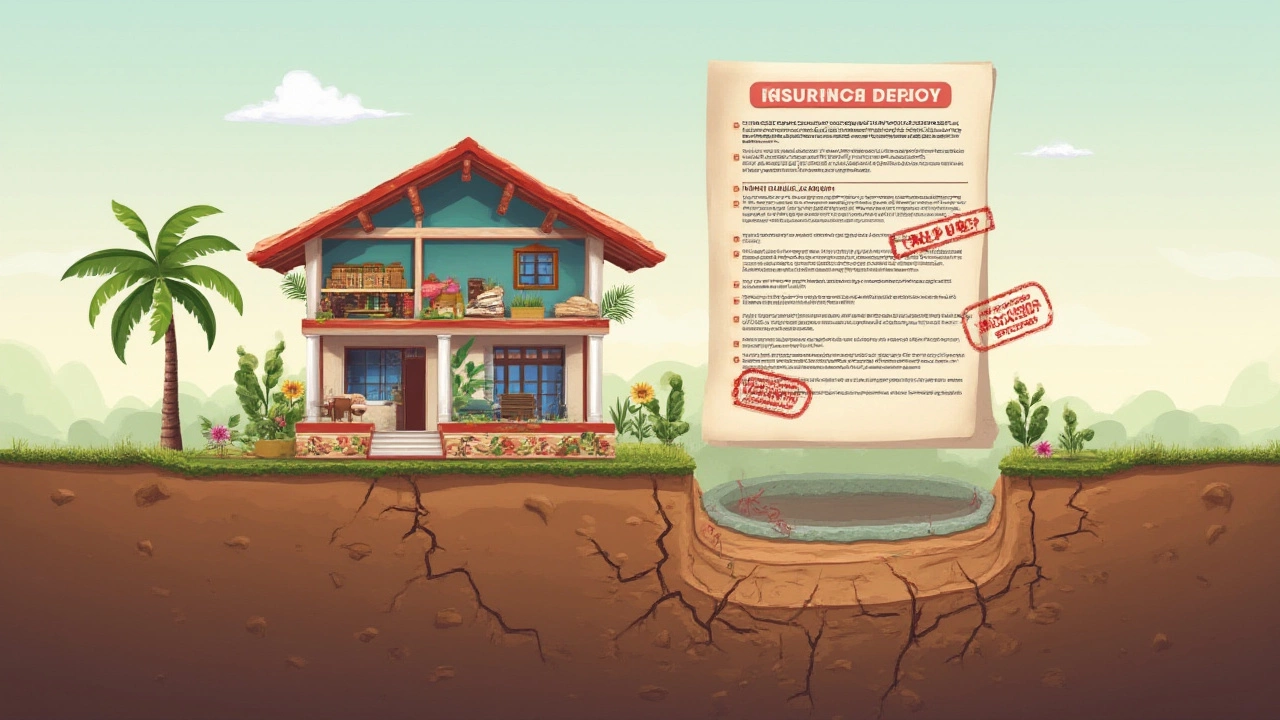Why Homeowners Insurance Won't Cover Foundation Damage: What Every Homeowner Needs to Know
You buy homeowners coverage expecting a safety net for your biggest investment. But when a crack zigzags across your basement and you call the insurer, you hit a brick wall: foundation repairs aren’t covered. It feels like a punch to the gut. Why do insurance companies draw the line at the very ground your house stands on? Let’s break open the secrets behind this frustrating policy blind spot.
The Truth About Homeowners Insurance and Foundations
Most people assume homeowners insurance is designed as a catch-all, swooping in when disaster strikes. House fire? Covered. Burglary? Covered. A tree falls on the roof? Covered. But scroll through the fine print or actually speak to an insurance adjuster, and you’ll find a different story for foundation damage. Almost every standard policy in the U.S. draws a hard boundary around foundations, treating them like forbidden territory. But why do insurance companies exclude foundations when other parts of the house are fair game?
For starters, insurers see the foundation as something that’s likely to wear down from factors outside unexpected accidents. Foundations are more often damaged by slow-moving issues — soil expansion, groundwater, or natural settling — rather than one-off, sudden events. Unlike fire or vandalism, these causes are long-term and gradual. And as far as the insurance industry is concerned, that makes all the difference. Their logic is simple: if something happens slowly over the years, it’s the homeowner’s job to notice, maintain, and act before things spiral. Insurers are wary of footing the bill for what looks a lot like neglect, not “sudden and accidental” events.
According to the National Association of Insurance Commissioners, less than 8% of homeowners claims are related to structural or foundation issues — and even then, most of those claims get denied. Instead, insurance is mainly tailored to blunt trauma: tornadoes, hail, or pipe bursts. One report from the Insurance Information Institute reveals that water-related claims are among the most common, but even with water damage, coverage often applies to things like burst pipes or accidental leaks, not to the years of creeping water that saturate the soil and shift your foundation.
You might think a policy upgrade solves this. Actually, add-ons like ‘earthquake insurance’ or ‘flood insurance’ protect against some foundation risks, but only if your home is rocked by seismic activity or swamped by flooding. If you live in regions like California or Florida, taking out extra coverage is basically mandatory. But for the slow crawl of clay soil swelling after heavy rain, or houses built on poorly compacted lots, the standard exclusions still hold. The insurer considers such issues part of “wear and tear” or “maintenance.”

Hidden Risks, Common Exclusions, and How They Affect You
So what specific causes do insurers usually blacklist when it comes to foundation coverage? If your home sits on clay — notorious for expanding and shrinking as water levels change — you’re in a tricky spot. The most common foundation issues stem from the earth itself: “settlement” (the house sinking as the soil compresses), soil movement after heavy rain or drought, “hydrostatic pressure” (water pushing against the foundation), and poor drainage. Every one of these shows up in stark terms on your insurance exclusion list.
Then there’s natural disasters. Earthquakes are a big foundation-smasher, but the standard policy says nope. Want coverage for a quake or sinkhole? You have to bolt on a separate endorsement, and that usually comes with sky-high deductibles. Floods are another biggie: if encroaching groundwater or a flash flood eats away at your slab, that’s squarely in the zone of special, separate flood insurance. Even then, fine print can trap you — if, say, your foundation cracks from “earth movement” after a flood, but not from actual floodwater, insurers sometimes pass the buck.
Mistakes during construction? Not covered. Foundations poured badly back in the ‘70s or shortcuts taken by the lowest-bid contractor don’t fall under your homeowners policy. Insurers point out that you, as the current owner, are responsible for hiring home inspectors and catching flaws—even if you weren’t living there when it happened. Unfortunately, poorly designed drainage systems or improper grading from decades ago are now your headache, not your insurer’s.
Insurance companies also treat pests as a maintenance issue. If termites gobble away at the wood framing near your foundation and cause a nasty tilt or collapse, you’re on your own. Same goes for mold — insurance treats it as something homeowners should keep at bay.
But here’s a weird twist: sometimes, if foundation damage is caused by a covered event — say, your washing machine hose bursts and water pours under the slab, or a car crashes through your garage wall and destabilizes the footing — the insurance might step up. These are rare situations because the damage must be sudden, accidental, and clearly linked to a covered peril. It starts getting complicated when the cause has even a hint of “gradual progression.”
Many homeowners only learn these realities the hard way. They pay the premiums, skip yearly checkups, and discover issues after something goes (literally) sideways. When cracks bloom across basement walls or doors refuse to close, the repair bill can top $10,000, and that’s before you even get to the root cause. Multiple studies, including one from the U.S. Department of Housing and Urban Development in 2023, found the average foundation repair tops $13,500 nationwide — and none of that comes from regular insurance payouts. Put bluntly, the foundation is where insurance coverage is most porous.

What Homeowners Can Actually Do to Protect Their Foundations
If the system isn’t set up to bail you out, what steps can you actually take to dodge the worst? First, know your soil. Look up your neighborhood on a soil map or ask a local foundation repair firm what kind of movement is most common. Sandy, loamy soils are pretty stable. Clay-heavy regions? Those are foundation nightmares after wet or dry spells. If you’re house-hunting, invest in a top-tier inspection and walk away from properties with even small foundation flags.
If you already own a home, regular maintenance is your real insurance. That means keeping gutters and downspouts working, so water moves far away from the slab. Make sure yard grading slopes gently away from your home on all sides—too many folks notice puddles collecting by the foundation months or years too late. Watch for trees and big shrubs; their thirsty roots can sneak under slabs and shift the soil. The Texas A&M Agrilife Extension suggests keeping big trees at least 15–20 feet away from your home’s edge.
Not all cracks are panic-worthy — hairline cracks under half an inch wide can simply be signs of normal settling. But if doors or windows start sticking, or if cracks widen over time, it’s time to call a licensed foundation specialist. Waiting only lets water, pests, or shifting soil do more damage, driving up repair costs. These specialists often use high-tech gadgets like laser levels to track movement or sonar to see voids under the slab. Don’t try to DIY diagnostics using YouTube videos — this is where local experience really matters. If you spot significant cracks or your house feels uneven when you walk through, get it checked pronto.
Document everything, especially if you think the damage follows a covered event, like a pipe burst or a storm. Insurers want photos, written reports, and time-stamped notes — the more evidence you have linking your foundation’s problems to a sudden incident, the better.
There are also some insurance tweaks that help. In certain states, you can add “foundation water damage” riders to your policy, but coverage and availability are spotty. If you live in an earthquake- or flood-prone area, those add-ons aren’t optional. Sure, the premiums are high, but not having them means rolling the dice on losing thousands, or sometimes the entire home. Don’t just settle for “replacement cost” coverage — those policies often don’t pay the full price for extensive foundation work.
If you’re unlucky enough to get hit by damage and your claim is denied, don’t just take no for an answer. Many states have appeals processes, and licensed public adjusters can sometimes help homeowners twist the insurer’s arm, especially if there’s a whiff that the damage ties back to a covered event or shoddy repairs authorized by previous claims. It’s not a guarantee, but fighting back occasionally gets results.
Here’s one more tough pill: data from the Foundation Repair Association shows homes built since the 1990s are a bit less likely to suffer catastrophic cracks, thanks to modern building codes and soil testing, but even then, some regions are just cursed with unpredictable ground shifts. If you’re building new, ask your contractor about soil stabilization, proper drainage systems, and pier-and-beam foundations—these small up-front costs save years of trouble.
So what’s the smart move? Treat your foundation like a “hands-on” part of homeownership. Do inspections after heavy rains or droughts. Budget for occasional repairs—much like you’d set aside cash for a new roof someday. And know exactly what your policy does (and doesn’t) cover by asking your insurer for a written breakdown. It’s boring, but it beats writing a massive check when your basement starts sliding sideways.
- Check soil type before buying or building
- Inspect foundation after big storms
- Direct water away from your house with proper grading and downspouts
- Keep trees 15–20 feet away from the foundation
- Don’t ignore early warning signs—sticky doors, widening cracks, uneven floors
- Take photos and notes after damage for any potential insurance claim
- Review your coverage and ask about riders or extra policies in risk-prone areas
- Get professional inspections every few years—don’t just rely on your own eyes
- Appeal denied claims if you suspect the damage links to a covered event
Look, homeowners insurance and foundations are a mismatched pair. Insurers won’t lift a finger for the most common cracks and shifts. But knowing what’s excluded, why, and what you can do about it means you’re not left stumbling when ground truth gets ugly. Foundation insurance isn’t a simple add-on—it’s a game of maintenance, vigilance, and sometimes creative wrangling with adjusters. Treat your foundation as non-negotiable, stay alert for early signs, and don’t let boring routine save you from a very expensive surprise down the line.







Comments